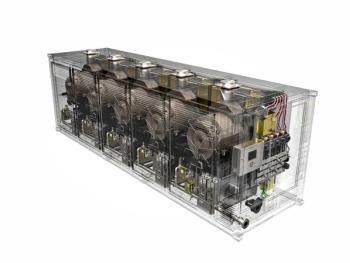
Prompt NOx, fuel NOx and thermal NOx: The DLE strategy
NOx is a generic term for the oxides of nitrogen, NO and NO2. All that is required to form NOx is to bring air to very high temperature, especially in the presence of radical species that are readily available during combustion. NOx is formed as NO in the flame zone of the combustor and partially oxidizes to NO2 downstream within the combustor. The split between NO and NO2 can be important for visible exhaust plumes, since it is the NO2 that gives the exhaust a brown hue. NOx is an environmental concern for several reasons.
When NOx and volatile organic compounds react in the presence of sunlight in the atmosphere, they form photochemical smog, a significant form of air pollution. The ground level ozone that is created can cause damage to lung tissue and a reduction in lung function. NO2 gives smog its brown haze.
This article contains excerpts from the paper, "Gas turbine emissions improvements by advances in design, analysis, materials, manufacturing and control technology," by David M Stansel of Solar Turbines presented at the 2018 Turbomachinery Symposium.
The primary mechanisms of combustion-produced NOx include Thermal NOx, Prompt NOx, and Fuel NOx.
Thermal NOx
Sometimes called Zeldovich NOx, after the Russian physicist who described the mechanisms in his 1939 doctoral dissertation. Thermal NOx only requires nitrogen in the air to combine with O and OH radicals, which are in abundant supply in a flame. N2 + O → NO + N N + O2 → NO + O N + OH → NO + H
The reactions are highly temperature dependent, so the hotter the combustion, the more NOx is formed. The NOx formation rate is also pressure and residence time dependent. Decreasing any of these three reduces the NOx, but the exponential dependence on temperature makes reducing combustion temperature the key strategy to low NOx combustion. Fortunately, the thermal NOx formation rates are relatively slow; equilibrium concentrations are never reached in practical combustion devices.
Prompt NOx
The presence of a second mechanism leading to NOx formation was first proposed by Charles Fenimore and was termed “prompt NOx” in 1971. When thermal and fuel NOx are eliminated, some NOx formation was still observed. Fenimore attributed this to the reaction of atmospheric nitrogen with combustion radicals occurring in the earliest stages of combustion. CH´ + N2 → HCN + N´ N´ + OH → NO + H´ N´ + O2 → NO + O´ HCN + O2 → NO + CO + H´
Because this mechanism is not significantly temperature dependent, it becomes more important when other NOx formation mechanisms have been suppressed. Prompt NOx cannot be practically quenched because the length scales are so small. So, prompt NOx must be lived with and focus is normally placed on suppressing the other two main NOx mechanisms.
Fuel NOx
When nitrogen is chemically bonded to the fuel, essentially all of it converts to NOx in the exhaust. While most gaseous fuels, such as natural gas, are free of fuel bound nitrogen, it is often found in liquid and solid fuels. Untreated fuel oil can contain over 1,000 ppm of fuel bound nitrogen, which can result in over 40 ppm NOx in the exhaust just from this mechanism. Sulfur found in liquid fuels can also lead to acid rain and can poison the catalysts used for emissions control in automobiles and other combustion sources. Fortunately, refinery processes that remove sulfur also remove fuel bound nitrogen.
Ultra-Low Sulfur Diesel (ULSD), defined in ASTM D975 as containing less than 15 ppm sulfur, typically contains less than 10 ppm fuel bound nitrogen, which will add less than 1 ppm NOx to the exhaust. Low Sulfur Diesel (LSD) has less than 500 ppm sulfur and can add a few ppm NOx to the exhaust, while high sulfur diesel allows up to 5,000 ppm (0.5%) sulfur, accompanied by enough fuel bound nitrogen to produce an additional 50 ppm NOx, which is unacceptable in most areas where NOx is regulated.
The combination of the above mechanisms results in an exponential relationship between NOx and combustion primary zone temperature (Tpz) as shown.
- The best NOx is always achieved with perfect premixing of fuel and air.• NOx emissions for well-mixed systems are independent of flameholder geometry• A well-mixed flame is insensitive to pressure or inlet temperature. A diffusion flame is sensitive to both, leading to high pressure ratio engines having higher NOx than low pressure ratio machines. But a high pressure-ratio DLE system should be able to achieve the same NOx as a low pressure ratio machine. • NOx for a well-mixed system is independent of residence time. So a DLE system can have a larger combustor liner without increasing NOx. All the above conclusions are very fortunate and helpful in the design of a DLE system. Low NOx can simply be achieved by mixing well and holding a low Tpz. And low NOx is possible with any pressure ratio engine. Practical DLE combustion systems make use of a pilot circuit to aid combustion stability, particularly at low loads as engine fuel demand reduces and temperatures drop.
If the pilot is not also well-mixed, its NOx contribution will follow that of a diffusion flame system, with sensitivity to temperature, pressure, and residence time. For systems with diffusion or partially premixed pilots, the fraction of fuel to the pilot circuit must then be kept very low, typically less than 5% of the total fuel flow, to maintain low-emissions levels. At very low loads, where higher pilot may be required, NOx can be higher than at full load. In contrast, the diffusion flame combustor has highest NOx at the highest loads.
Newsletter
Power your knowledge with the latest in turbine technology, engineering advances, and energy solutions—subscribe to Turbomachinery International today.




